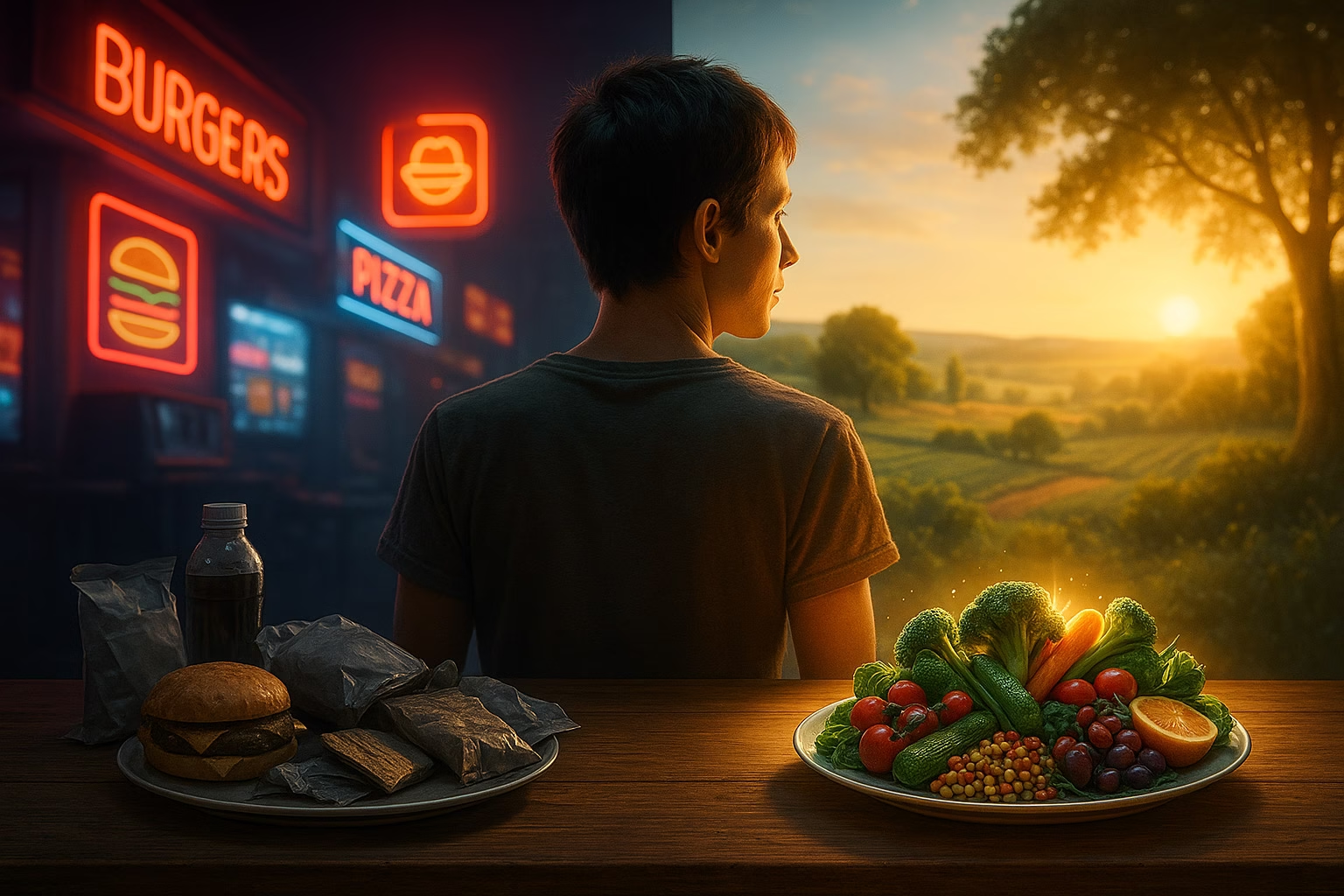PODCAST: Overcoming Processed Food Addiction
Introduction: The Autopilot of a Disconnected World
The evening hums with a familiar, silent rhythm. The phone, a portal to endless possibility and effortless consumption, lights up with a push notification. A simple swipe and a few taps, and a meal is in motion, ferried by a stranger to a doorstep. The ritual is complete not with the sizzle of a pan or the aroma of a home-cooked meal, but with the tearing of a bag and the click of a television remote. This is the new normal—a world where nourishment has been reduced to a transaction of convenience, consumed mindlessly, often in front of a screen, and forgotten the moment the last bite is swallowed. This is life on autopilot, and for many, it is the only way of life they have ever known.
Yet, a deeper truth awaits beyond the veil of convenience. The visionary works of Fractal – The Trilogy and The Oracle 2.0 offer a profound re-evaluation of this modern existence, providing a foundational wisdom: “food is a relationship, not just fuel”. When the relationship with food is broken, it becomes a reflection of a larger societal and personal disconnection. The path to healing this relationship is a journey back to self, a process of awakening that begins not with a grand gesture, but with the simple, profound act of conscious nourishment. This journey is a microcosm of a larger transformation, a physical embodiment of the fractal principle that states, “How we are at the small scale is how we are at the large scale. The patterns of the universe repeat at scale”. Overcoming the lure of processed foods is not merely a diet but a sacred act of alignment—a step towards remembering who we already are.
Part I: The Disconnected Reality: Why Processed Food Thrives
The Ecosystem of Disconnection: A Perfect Storm for Processed Foods
The ubiquity of processed and ultra-processed foods (UPFs) is not an accident; it is the natural consequence of a world that has prioritized speed, efficiency, and convenience over all else. The modern, fast-paced lifestyle, driven by increased urbanization, changes in the labor market, and a rise in the number of women working outside the home, has created a fertile ground for these foods to flourish. When time is a luxury and the day is a relentless series of tasks, the demand for cheap, fast, and easy food becomes overwhelming. This is the societal vacuum that UPFs were engineered to fill.
The economic dynamics of the global food system further entrench this reality. A new report from the Food and Agriculture Organization of the United Nations (FAO) highlights that international trade makes food more affordable and available. However, this trade also accelerates the consumption of high-fat, high-sugar, and high-salt foods with low nutritional value. The economic picture is nuanced: in high-income countries, UPF consumption is often highest among lower-socioeconomic classes, driven by affordability and advertising. Conversely, in many low- and middle-income countries, consuming these modern, packaged foods is a marker of rising income and socioeconomic status. This dual dynamic illustrates how the processed food industry capitalizes on both scarcity and prosperity, adapting its model to capture a global market.
The data reveals a stark, global truth: the consumption of ultra-processed foods is not just a trend but a dominant dietary paradigm. In the United States, UPFs make up a staggering 73% of the food supply. Globally, the dietary energy contribution of UPFs is exceptionally high in high-income countries like the United States (58.8%), the United Kingdom (56.8%), and Canada (47.7%). The FAO report shows that a mere 10% increase in income results in an 11% increase in demand for imported UPFs, a rate faster than that for unprocessed foods.
Perhaps the most alarming trend is the one seen across generations. Youth, ages 1–18, consume a disproportionately high percentage of their calories from ultra-processed foods (61.9%) compared to adults (53.0%). This is not simply a matter of poor diet choices; it signifies a deep, intergenerational crisis. The societal demand for convenience, which is a symptom of collective disconnection, is met by an industry that creates highly addictive products. These products, by hijacking the brain’s reward systems, further isolate the individual from their body and the natural world, reinforcing the initial state of disconnection. This is a self-perpetuating, negative feedback loop that operates at both a personal and collective level. The high consumption among youth suggests that a progressive, long-term disorder is being normalized in a new generation, implying that the journey of awakening must now begin earlier and be more forceful to counter these deeply ingrained patterns.
Table 1: The Global Rise of Ultra-Processed Foods
This table provides a data-driven look at the prevalence of ultra-processed foods in our global diet. The percentages reveal not only the scale of the problem but also the nuanced socioeconomic factors at play, from high-income nations to those in earlier stages of economic development.
Region/Demographic | Mean % of Total Calories from UPFs |
|---|---|
High-Income Countries | |
United States (Overall) | 58.8% |
United Kingdom (Overall) | 56.8% |
Canada (Overall) | 47.7% |
Youth vs. Adults (US Data) | |
Youth (Ages 1-18) | 61.9% |
Adults (Age 19+) | 53.0% |
Low-to-Middle-Income Countries | |
Brazil (Overall) | 20.4% |
Mexico (Overall) | 29.8% |
The Engineered Hook: A Neurological Sabotage
The modern diet is not a testament to poor willpower; it is a testament to the sophistication of food science. Many ultra-processed foods are engineered in a lab to be “edible, palatable and habit-forming”. Food corporations spend vast resources to find the perfect combination of salt, sugar, and fat—a sensory profile known as the “bliss point”. The pursuit of this optimal blend is a deliberate act of neurological sabotage.
When a food hits the bliss point, it causes a rapid spike in dopamine, a neurotransmitter in the brain responsible for feelings of pleasure and well-being. This euphoric spike is followed by an inevitable crash, which creates a powerful, biological craving to feel good once more. The cycle of consumption is thus perpetuated not by hunger but by the desire to chase that fleeting sensation of pleasure. A 2023 review of 281 studies found that the combination of refined carbohydrates and fats in ultra-processed foods has a “supra-additive effect on brain reward systems,” meaning the addictive potential is greater than either macronutrient alone. The speed at which these foods deliver carbs and fats to the brain is a key factor in their addictive potential, a mechanism similar to how fast-acting drugs like cocaine have a higher addictive potential. This body of evidence provides a sobering conclusion: some ultra-processed foods can be as addictive as cigarettes and cocaine.
The hold of these foods is also deeply enmeshed with memory. The memories created for food are often stronger and longer-lasting than those for any other substance, with childhood food memories wielding a powerful influence over eating habits for the rest of an individual’s life. A study of individuals with “food addiction” found that they exhibited patterns of neural activation associated with “reduced inhibitory control,” suggesting that the palatability of these foods can override a person’s desire to limit consumption. The problem, therefore, is not a lack of self-control but a physiological response to a product engineered to bypass it.
Part II: The Hidden Costs of a Lost Relationship
The Physical Burden: From Gut to Brain
The reliance on a processed diet carries hidden physical costs that extend far beyond mere weight gain. At the heart of this physical burden is a state of low-grade, systemic inflammation. The body views the chemical additives, preservatives, refined sugars, and trans fats in ultra-processed foods as foreign invaders, triggering a chronic immune response. This persistent inflammation is not a temporary discomfort but a central driver of nearly every major chronic disease, including cardiovascular disease, type 2 diabetes, autoimmune disorders, and certain cancers.
This inflammatory cascade often begins in the gut, the body’s second brain. Ultra-processed foods disrupt the delicate balance of the gut microbiome, leading to a decrease in beneficial, anti-inflammatory bacterial strains and an increase in potentially harmful, pro-inflammatory ones. This disruption can degrade the gut lining, leading to a condition known as “leaky gut syndrome,” where toxins and undigested food particles pass into the bloodstream, triggering widespread inflammation. This physical damage has a direct impact on the mind. The gut and brain are in constant communication via the vagus nerve, and an inflamed gut can lead to neurological disorders and poorer psychological functioning. The physical and mental consequences of UPFs are not isolated; they form a self-reinforcing, cascading chain reaction that links societal disconnection to a state of chronic, internal disease.
The Emotional and Spiritual Famine
Beyond the physical, a processed diet exacts a profound emotional and spiritual toll. Many individuals reach for ultra-processed foods to cope with emotional distress, be it stress, anxiety, or sadness. These foods provide a fleeting, temporary boost in positive emotions, but this effect is short-lived, failing to address the underlying issues. This reliance on food as a “crutch for emotions” reinforces an unhealthy relationship, where nourishment is sought not for wellness but for temporary escape.
The deeper cost, however, is a spiritual famine. The modern, mindless consumption of food has severed our connection to its source and its role as a sacred ritual. This loss creates a spiritual void—a “deeper longing or hunger” that is often mistaken for physical hunger. This state of “spiritual depletion” leads individuals to eat to “self-soothe, cope, or escape our feelings” rather than to nourish their body’s innate wisdom. While traditional cultures use food rituals to foster gratitude, community, and connection , the modern, solitary consumption of ultra-processed foods in front of a screen is a ritual of isolation and self-sabotage. It is a perversion of nourishment—an act of disconnection that mirrors the spiritual void it tries to fill.
The hidden costs are interconnected. Societal disconnection leads to the use of food as an emotional coping mechanism. This reliance on hyper-palatable UPFs damages the gut and triggers chronic inflammation. This inflammation, via the gut-brain axis, impairs mental health , leading to more emotional eating and a deepening of the addiction. The “lost relationship” is both a symptom and a cause of this escalating cycle of physical and mental decline, a profound and costly feedback loop of self-harm.
Table 2: The Hidden Costs of a Lost Relationship
This table summarizes the multi-dimensional toll of a processed food diet, categorizing the consequences into physical, emotional, and spiritual domains. It illustrates the far-reaching impact of the problem beyond a simple health issue.
Domain | Consequences | Supporting Research |
|---|---|---|
Physical | Chronic systemic inflammation; Gut dysbiosis; Leaky gut syndrome; Elevated risk of chronic diseases (CVD, Type 2 diabetes, cancer); Oxidative stress; Nutrient depletion | |
Emotional | Stress and emotional eating; Short-lived positive emotional effects; Reinforcement of unhealthy coping mechanisms; Vicious cycle of physical and mental decline | |
Spiritual | Loss of food as ritual and gratitude; Disconnection from the source of food; Spiritual depletion and a sense of “deeper longing”; Eating to self-soothe rather than to nourish |
Part III: The Path to Conscious Nourishment
Reclaiming the Relationship: The Practice of Mindful Eating
The journey back to a conscious relationship with food begins with a simple, yet radical act: the practice of mindful eating. This is not a diet but a meditative, “judgement-free” practice of being fully present with one’s food. The objective is to train the brain to find pleasure in a more subtle, natural way, slowly but surely rewiring the hijacked reward pathways created by ultra-processed foods. This practice is a form of neurological alchemy, designed to counteract the fast, hyper-palatable “bliss points” by forcing the brain to find satisfaction in the slow, nuanced experience of eating natural foods.
Several practical techniques can be implemented:
- Engage All Senses: Take time to notice the colors, shapes, and aromas of the food before a single bite is taken. Feel the textures and listen for the sounds of a meal, like the crunch of a fresh vegetable.
- Slow Down the Pace: Chew each bite thoroughly and deliberately, and put utensils down between bites. This gives the body time to signal that it is satisfied, not stuffed, helping to avoid overeating.
- Eliminate Distractions: Turn off the television, put away the phone, and sit at a table to eat. The goal is to focus exclusively on the meal, fostering a deeper sense of appreciation and preventing the mindless consumption that so often accompanies distractions.
The benefits of this practice are manifold. Mindful eating helps individuals distinguish between emotional hunger and physical hunger, leading to a better understanding of one’s motivations for eating. This awareness can significantly reduce emotional and binge eating behaviors.
A Return to the Source: Reconnecting with Natural Foods
The second step on the path to conscious nourishment is a return to natural foods. Unlike ultra-processed foods, which are manufactured in a lab, whole foods are “closest to their natural state” and provide the essential nutrients the body needs to thrive. Choosing fresh fruits, vegetables, grains, nuts, and seeds is an act of re-alignment, a deliberate choice to nourish the body with what it was designed to consume.
This re-engagement goes beyond the shopping list. It is an invitation to reconnect with the entire process of food creation. The act of cooking and preparing food can be a creative outlet and a more “full experience” that begins in the kitchen and extends to the table. This practice helps rebuild the lost relationship with food from the ground up, transforming it from a mere commodity into an act of care.
From Addict to Alchemist: Practical Antidotes for the Journey
Reclaiming a healthy relationship with food requires disrupting the triggers that lead to consumption. A simple yet powerful tool is food and mood journaling, where individuals can write down what they eat and how they feel at the time of consumption. This practice reveals patterns and emotional triggers, helping a person make a “different choice” when the urge arises. Strategic planning is also a vital antidote, which involves making a shopping list, keeping healthy food readily available, and avoiding shopping while hungry to prevent unhealthy impulse buys.
A critical element of this journey is reframing the narrative. An individual must stop viewing food they enjoy as something to be “cheated on.” Instead, they can embrace a more flexible mindset, seeing healthy eating as a “puzzle we can solve with wisdom and flexibility”.
For some, however, processed food consumption is a serious, chronic addiction that may require professional help. Research shows that ultra-processed food addiction (UPFA) is a clinical syndrome with distinct stages, and a single dietary intervention is often not effective. Evidence-based treatments like Cognitive Behavioral Therapy (CBT-E) can provide individuals with skills to cope with triggers and manage their emotions, fostering healthy, regular eating habits. Other approaches, such as harm reduction and abstinence protocols, are also being explored for severe cases, recognizing the need for a high level of support similar to that used for substance use disorders.
The Sacred Bite: Cultivating Gratitude as a Ritual
The final, transformative step is to view every bite as a sacred act. Cultivating gratitude is a powerful practice that deepens the eating experience and honors the entire supply chain, from the soil to the hands that prepared the meal. This is not merely a rote prayer but a conscious moment of reflection and appreciation.
Cultures around the world have long understood this principle. The Japanese “sado” tea ceremony is a ritualized practice of mindfulness and connection. The communal act of making tamales in Mexico or dumplings in China is a cherished tradition that strengthens social bonds and preserves ancestral recipes. These rituals serve as a blueprint for a new way of being.
An individual can begin by creating their own small rituals—whether it’s a moment of deep breathing, a silent blessing, or simply a moment of reflection before eating. This practice transforms every meal from a mindless act into a sacred one, a powerful act of rebellion against the forces of disconnection.
Table 3: From Addiction to Alignment: A Practical Guide
This table provides a clear, easy-to-reference blueprint for the journey of conscious nourishment. It summarizes the core solutions discussed in the report, making the abstract concepts of mindful eating and gratitude practical and actionable.
Practice | How It Works | Practical Action Steps |
|---|---|---|
Mindful Eating | Retrains the brain to appreciate natural foods; Differentiates between physical and emotional hunger; Reduces binge and emotional eating | Eat without distractions; Engage all senses; Chew slowly and put down utensils between bites |
Food & Mood Journaling | Reveals triggers and patterns; Creates self-awareness; Provides a moment to interrupt automatic responses | Write down what is eaten and how you are feeling at the time; Note when stress or boredom triggers eating |
Strategic Planning | Reduces unhealthy impulse buys; Ensures healthy options are readily available; Breaks the fast-paced convenience loop | Shop with a list; Avoid shopping when hungry; Keep healthy snacks prepared in advance |
Gratitude Rituals | Cultivates appreciation for food; Deepens the eating experience; Reclaims a sacred relationship with nourishment | Take a deep breath before a meal; Reflect on where the food came from and the people who prepared it; Create small, personal traditions |
Conclusion: The Awakening is on Your Plate
The journey from a state of mindless disconnection and addiction to a practice of conscious nourishment is one of profound significance. It is a path that reveals a powerful truth: the problem with processed food is not merely physical, but deeply rooted in our emotional and spiritual landscape. The forces that have created a world on autopilot are the same forces that have turned food from a relationship into a transaction.
But every moment of awareness is an act of rebellion. Every single bite, when chosen with intention and consumed with presence, is a choice. It is an act of alignment with the body’s true needs or a step toward further disconnection. The choice to practice conscious nourishment is a microcosmic awakening, a small-scale act of alignment that, when multiplied across many individuals, creates a collective consciousness of health and purpose. As the vision of Fractal suggests, “a better you creates a better world”. By choosing conscious nourishment, an individual is not just transforming their health; they are participating in a larger awakening of presence, purpose, and spiritual clarity. The first step on this transformative journey begins not with a grand resolution, but with a single, sacred bite.
Bibliografia
- Fractal – The Trilogy: Fractal – A Sci-Fi Trilogy Exploring …, https://fractalthetrilogy.com/
- Fractals – Ami Worthen, https://amiworthen.com/2017/12/11/fractals/
- Socioeconomic Characteristics and Trends in the Consumption of …, https://www.mdpi.com/2072-6643/13/4/1120
- New FAO report offers guidance and data on integrating nutrition …, https://www.fao.org/newsroom/detail/new-fao-report-offers-guidance-and-data-on-integrating-nutrition-goals-into-food-trade-policies/en
- Avoiding social divides in ultra-processed food laws | The BMJ, https://www.bmj.com/content/384/bmj-2023-077310/rr-2
- ‘Bipartisan, common sense, science-based’: California leads the way in banning ultra-processed school meals, https://www.theguardian.com/environment/2025/sep/15/california-ultra-processed-foods-schools
- Ultra-processed foods A global threat to public health, https://www.globalfoodresearchprogram.org/wp-content/uploads/2023/11/GFRP_FactSheet_UltraProcessedFoods_2023_11.pdf
- Products – Data Briefs – Number 536 – August 2025 – CDC, https://www.cdc.gov/nchs/products/databriefs/db536.htm
- NCHS Data Brief No. 536 August 2025 – CDC, https://www.cdc.gov/nchs/data/databriefs/db536.pdf
- Some ultra-processed foods are as addictive as cigarettes and …, https://usrtk.org/ultra-processed-foods/addictive/
- How processed food causes inflammation – Women’s Health Network, https://www.womenshealthnetwork.com/nutrition/how-processed-food-causes-inflammation-the-common-cause-of-chronic-disease/
- Eating ultra-processed foods harms your gut—here’s how …, https://www.news-medical.net/news/20250306/Eating-ultra-processed-foods-harms-your-gute28094heree28099s-how-inflammation-takes-hold.aspx
- Ultra-Processed Foods and Mental Health: Where Do Eating Disorders Fit into the Puzzle?, https://pmc.ncbi.nlm.nih.gov/articles/PMC11206753/
- Eating Well for Mental Health | Sutter Health, https://www.sutterhealth.org/health/eating-well-for-mental-health
- How did you improve your relationship with food? : r/loseit – Reddit, https://www.reddit.com/r/loseit/comments/12eh9s6/how_did_you_improve_your_relationship_with_food/
- Highly processed food intake and immediate and future emotions in everyday life – PMC, https://pmc.ncbi.nlm.nih.gov/articles/PMC8886797/
- Spirituality, Food Ideologies, and Diets, https://spiritualawakeningprocess.com/2015/01/spirituality-food-ideologies-and-diets.html
- Spiritual Depletion and Emotional Eating–Part II – Overeating Recovery, https://overeatingrecovery.com/emotional-eating/spiritual-depletion-and-emotional-eating-part-ii/
- The Role of Ritual in Eating | Departments, https://departments.wheatoncollege.edu/wp-content/uploads/2023/10/Brumberg-Kraus2020_ReferenceWorkEntry_TheRoleOfRitualInEating-copy.pdf
- Food Culture: 36 Culinary Traditions Around the Globe – Littera24, https://littera24.com/en/food-culture-36-cultural-traditions-around-the-globe/
- Mindful Eating • The Nutrition Source, https://nutritionsource.hsph.harvard.edu/mindful-eating/
- Mindful Eating: Connecting with Natural Foods for Better Health – Juno Bamboo Water, https://bamboo-water.com/blogs/bamboo-water-articles/mindful-eating-connecting-with-natural-foods-for-better-health
- Mindful Eating – Reconnecting with Food | First Coast YMCA, https://fcymca.org/your-stories/blog/mindful-eating-reconnecting-with-food/
- Benefits of Mindful Eating in Recovery | Casa Serena | Women’s Treatment Center, https://casaserena.org/2024/03/08/benefits-of-mindful-eating/
- Mindful Eating: Benefits, Challenges, and Strategies | USU, https://extension.usu.edu/nutrition/research/mindful-eating
- The Connection Between Diet and Mental Health – McLean Hospital, https://www.mcleanhospital.org/essential/nutrition
- One size does not fit all: Understanding the five stages of ultra-processed food addiction, https://journalofmetabolichealth.org/index.php/jmh/article/view/90/299
- Treatment Approaches – National Eating Disorders Collaboration, https://nedc.com.au/eating-disorders/treatment-and-recovery/treatment-approaches
- Binge-eating disorder – Diagnosis and treatment – Mayo Clinic, https://www.mayoclinic.org/diseases-conditions/binge-eating-disorder/diagnosis-treatment/drc-20353633
- Binge-type eating disorders and ultra-processed food addiction: phenomenology, pathophysiology and treatment implications – Frontiers, https://www.frontiersin.org/journals/psychiatry/articles/10.3389/fpsyt.2025.1584891/full




